Basic Color Genetics
*Disclaimer: Some of the photos and text seen here have been copied from google. If you are looking to receive credit for your work, please send us an email. We would be happy to give credit.*
Recognized colors (and color names) will vary from breed to breed, but genetics never change. Learning genetics will help any breeder, who is trying to achieve showable colors, or those who are trying to avoid certain colors. I have done my best to put together this basic guide in hopes it can help beginners.
A Locus
A- Agouti
Agouti is the most dominant gene on the A locus. it can carry A, at, or a.
Chestnut/Castor (Black Based)
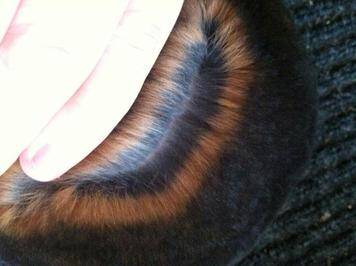
Chestnut (Castor in Rex breeds) is a rich mahogany/brown color. Think wild rabbit. The under-color is slate blue or white with an orange intermediate band of color. The ears are laced in black. The surface color of the belly, eye circles, and jowls is cream. The eyes are brown.
Opal (Blue Based)

Opal is a color with a deep blue fur on its back that transitions to a lighter white or tan belly area. The lighter color can also be seen around the eyes and often on the tail. Your will also see rings of color when blown into the fur.
Amber (Chocolate Based)

The surface color is reddish brown with a golden orange intermediate color. The under color on the Amber is dove gray. There will be a light chocolate tipping evenly throughout. The belly will be a cream over a dove gray under color.
Lynx (Lilac Based)
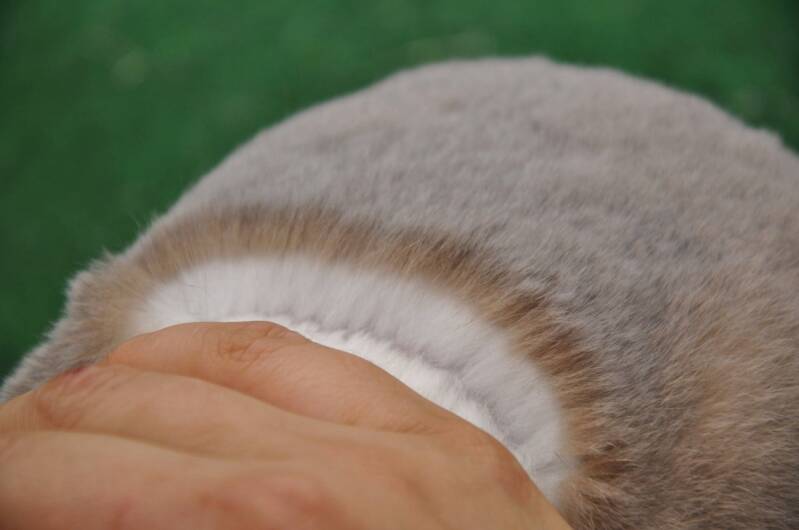
The body should have a white under color next to the skin followed by a crisp clean bright fawn intermediate band/ring of color. The surface should be fawn intermixed with dove gray. The intermediate band/ring and under color should be equal in width.
at- Otter, Marten
Recessive to Agouti, and cannot carry agouti, but it can carry at or a
Otter

Otter is a pattern, that shows tan lacing around the ears, eyes, nostrils, and belly on a solid-colored rabbit.
Marten

Marten is a pattern, that shows silver lacing around the ears, eyes, nostrils, and belly on a solid-colored rabbit.
a- Self
Self is the most recessive gene on the A Locus, it can only carry itself, a
Black

The entire body should be a rich lustrous black that runs deep toward the skin. The under color should be slate blue in color. Eyes are brown and nails are dark.
Blue

The entire body should be an even deep blue gray in color that runs deep towards the skin. The under color should be a lighter blue gray. The eyes should be gray, and the nails should be dark.
Chocolate

The entire body should be a rich chocolate brown that runs deep towards the skin. The under color should be dove gray in color. The eyes should be brown (ruby cast), and the nails should be dark.
Lilac
The entire body should be an even dove gray with a slight pink tint to the surface. The color should run deep towards the skin to a lighter dove gray under color. The eyes should be Blue Gray (ruby cast) and the nails should show pigment.
B Locus
B- Black
Dominant over brown, and can carry B or b
Varieties include black (self), blue, castor (black-based agouti), and opal (blue-based agouti).

b- Brown
Recessive to black and can only carry itself.
Varieties include chocolate, lilac, amber (chocolate-based agouti), and lynx (lilac-based agouti)

C Locus
C- Full Color
This is the most dominant gene on the C Locus. It can carry C, cchd, cchl, ch or c.
The C gene is responsible for the pigment of a rabbit.
Chestnut

Rich mahogany or chestnut brown. When you blow into the fur, there should be distinct bands of color. The under-color is slate blue or white with an orange intermediate band of color. The ears are laced in black. The surface color of the belly, eye circles, and jowls is cream.
Tort

The surface color of the body should be a bright rusty red-orange which blends to a smoky gray-black on the flank, head, belly and feet. The surface color should extend as far down the hair shaft as possible to an off white under color.
cchd- Chinchilla (dark)
This gene is recessive to full color but dominant over cchl, ch or c. It can carry cchd, cchl, ch or c
cchl- Chinchilla (light)
It is recessive to full color and chinchilla (dark) but is Dominant over the others. It can carry cchl, ch or c
Chinchilla

The body should have a slate blue under color next to the skin followed by a crisp clean pearl white intermediate band. The surface of the coat should be pearl white intermixed with black. The intermediate band should be equal in width to the under color.
Sallander

A Sallander should have a light almost white body with dark gray to black shading, blue shading, chocolate shading or lilac shading on the nose, around the eyes, on the ears, feet, tail and often the belly depending on the variety of Sallander.
Sable (one cchl gene)
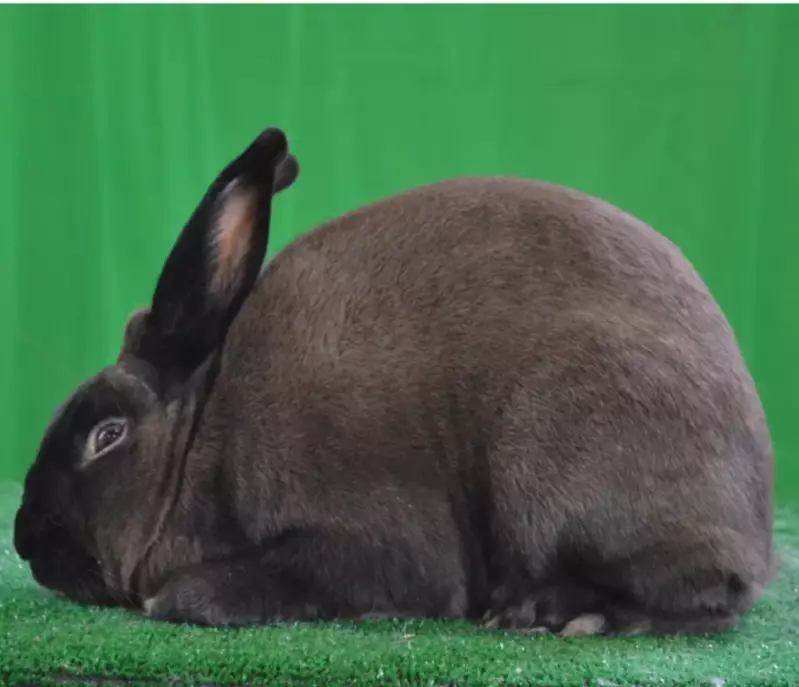
A sable should have a medium to dark sepia body with darker sepia to black shading on the nose, around the eyes, on the ears, feet and tail. The nails should be dark, and the eyes should be brown. A ruby glow is common.
Seal (two cchl genes)

A True Seal (two cchl genes) should have a dark Sepia brown body which shades to a slightly lighter sepia on the belly and flanks. A true Seal should have brown eyes lacking a Ruby Glow.
ch- Pointed White / Himalayan / Californian
It is recessive to C, cchd and cchl, but it's dominant over c. It can carry ch or c
(Eyes should be red/pink with the exception of sable point)
Black Himalayan

The body should be a clean white which extends completely down to the skin on all usable portions of the body. The ears, feet, nose, and tail should be a lustrous black. All point color should be as dark, distinct, and intense as possible. The color on the forefeet should extend well up the leg. The color on the hind feet should extend well up the leg to the hock joint.
Chocolate Himalayan

The body should be a clean white which extends completely down to the skin on all usable portions of the body. The ears, feet, nose, and tail should be brown. All point color should be as dark, distinct, and intense as possible. The color on the forefeet should extend well up the leg. The color on the hind feet should extend well up the leg to the hock joint.
Blue Himalayan

The body should be a clean white which extends completely down to the skin on all usable portions of the body. The ears, feet, nose, and tail should be a deep blue. All point color should be as dark, distinct, and intense as possible. The color on the forefeet should extend well up the leg. The color on the hind feet should extend well up the leg to the hock joint.
c- Albino / Red Eyed White
This gene is completely recessive and cannot carry anything but itself.


The body should be completely white and extend down to the skin. Nails should also be white, and eyes should be red/pink.
D Locus
D- Dense
This gene is dominant over dilute, but can carry d
d- Dilute
This gene is recessive to dense and cannot carry dense. it can carry itself. Breeding two dilute rabbits will result in 100% dilute kits.
Black

Chocolate

Blue
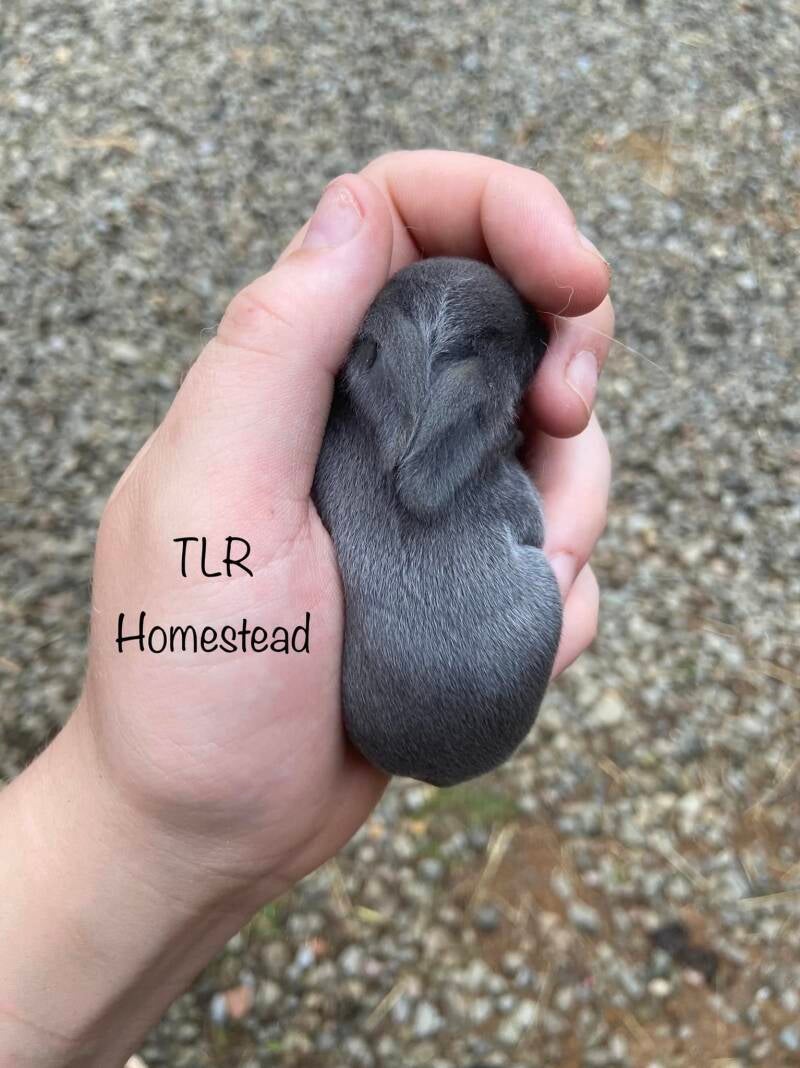
Lilac

E Locus
Es- Steel
Es is dominant over E, ej, and ee
Gold Tipped Steel

This is essentially a chestnut or castor, but instead of the fur having rings of color, the color is deposited as ticks on the tip of the hair shaft.
Silver Tipped Steel,

This is essentially a Chinchilla but instead of the fur having rings of color, the color is deposited as ticks on the tip of the hair shaft.
E- Full Extension
E is recessive to Es and recessive to ej and ee it can carry ej or ee
Rabbits who have one solid color along the entire hair shaft are considered to be full extension.
blacks, blues, chocolates, and lilacs are the most common.
ej- Harlequin / Tri
ej is dominant over ee but is recessive to Es, and E,
Harlequin

A solid variety recognized in 4 color combinations. In some breeds they also call this a Brindle
Tri

A broken variety recognized in 4 color combinations within that broken pattern's-colored portions.
Magpie

A solid variety recognized in 4 color combinations. This color also utilizes cchd from the C Locus
ee- Non Extension
ee is recessive to Es, E, and ej.
Black Tort
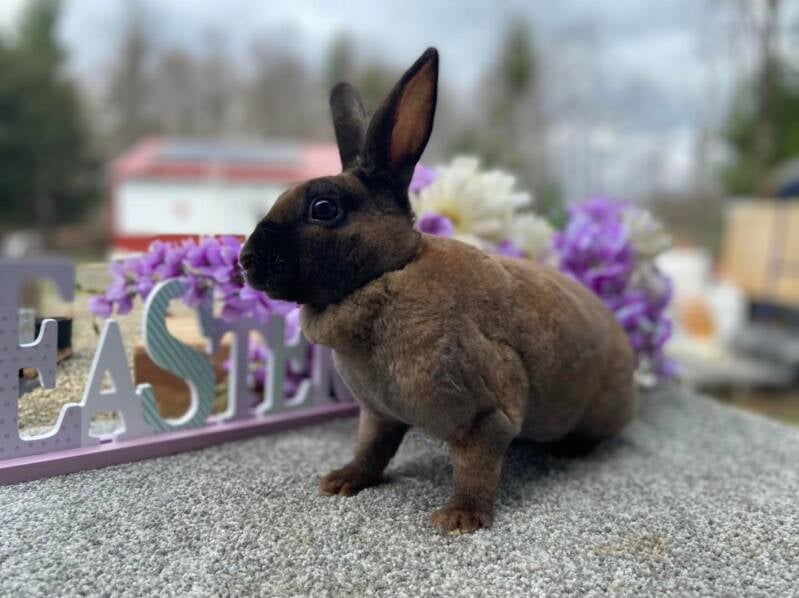
The surface color of the body should be a bright rusty red-orange which blends to a smoky gray-black on the flank, head, belly and feet. The surface color should extend as far down the hair shaft as possible to an off white under color.
Red

The body should be a clean bright intense orange in color that runs deep towards the skin to an off white under color. The head, outside of ears, back, hindquarters, sides of body, upper side of tail, and outside of feet should match the body color. These areas should have an appearance as close to a self as possible. The belly should be a light cream to off white with a slate blue under color next to the skin.
Extra Genes
Extra genes affect the way a rabbit's pattern is, changes eye color,
and sometimes changes their ear color.
Broken Genes
Enen = Broken (Dominant)
enen = Solid (Can not carry broken)
EnEn = Charlie - Double Broken Gene
Two solid rabbits will NEVER make a broke, but two brokens can make a solid. if a true charlie is bred to a solid, your litter will only be broken. If there's solid colors, chances are you have a false charlie
Breeding to Vienna or White ear may cause a mostly white rabbit. You may have a hard time deciding its color.

Vienna Genes
VV = Does not carry BEW / Vienna Gene
VC = Not Vienna Marked / Vienna Carrier
Vv / VM = Vienna Marked (blue eyes)
vv = Blue Eyed White
Two VM or VC rabbits can make a BEW. ANY rabbit from a VM or a VC should be labeled as a VC. this gene can hide for many many generations. White facial markings are common with VM.
Breeding to a broken may cause a Mostly White rabbit. You may have a hard time deciding its color.

White Ear Genes
WE = White Ear
WEWE = Double White Ear
A white ear rabbit is presented with pure white ears; however, one parent MUST be a WE for you to get a WE. This gene is not common, and only a few breeders are working with it. a double WE is a mostly white rabbit that comes from two WE parents. White facial markings are common.
Breeding to Vienna or broken can cause a rabbit to look like a double WE. You may have a hard time deciding its color

Create Your Own Website With Webador